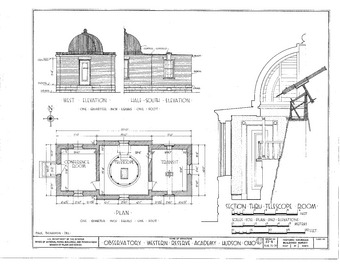Loomis Observatory facts for kids
Quick facts for kids |
|
|
Loomis Observatory
|
|

A three room Flemish bond brick building, 37’ by 16’, domed in copper over the central section.
|
|
| Lua error in Module:Location_map at line 420: attempt to index field 'wikibase' (a nil value). | |
| Location | Aurora St and College St, Hudson, Ohio |
|---|---|
| Area | less than one acre |
| Built | 1838 |
| Architect | Simeon Porter |
| NRHP reference No. | 75001539 |
| Added to NRHP | June 30, 1975 |
The Loomis Observatory is a very old building in Hudson, Ohio. It is one of the oldest observatories in the United States. An observatory is a special place where scientists watch the stars and planets.
This observatory was finished in 1838. It is located on the campus of Western Reserve Academy. This school helps students get ready for college. When the observatory was built, the school was called Western Reserve College. It later moved and is now known as Case Western Reserve University.
Contents
A Historic Star-Gazing Spot
The Loomis Observatory is special because it is the oldest observatory in the U.S. that is still in its original spot. Another old observatory, the Hopkins Observatory, was also built in 1838. But it has been moved two times since it was first built.
Who Built It?
Professor Elias Loomis helped design this observatory. He bought the tools needed for it in England. He had studied in Europe before this. The building itself was built by an architect named Simeon Porter.
Original Tools
Inside the observatory, you can still find some original tools. There is a special equatorial telescope made by Troughton & Simms. A telescope helps you see far-away objects like stars. There is also an astronomical clock made by Robert Molyneux. These tools are from 1837.
Important Scientists
A historical marker at the observatory tells us more. It says that Elias Loomis and Charles Augustus Young worked here. They were important scientists who studied the sky.
Restoring the Observatory
Over the years, the Loomis Observatory has been cared for. A person named James Ellsworth helped fix it up in 1908. It was also restored again in 1963. This helps keep this important building safe for the future.

